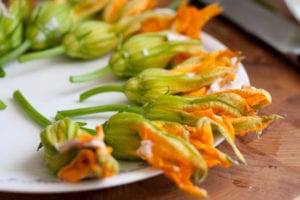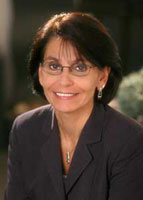By Barbara Beltrami
While the flowers that bloom in the spring (tra-la) may not provide a hearty repast for an appetite burning with spring fever (unless you’re a deer), many a posy can be used as an ingredient that is as pleasing to the palate as it is to the nose and eye. If you want to make flowers a centerpiece for an elegant or informal spring or summer meal, by all means stick them in that Waterford vase or ceramic pitcher you made in pottery class.
But if you want to adorn a gorgeous and memorable dessert, try candied violets and rose petals. And for one of the prettiest salads you’ve ever seen, toss in nasturtiums, pansies and lots of herbs. Looking for a knockout appetizer? Stuff squash blossoms with a mixture of ricotta, cream cheese and chives. So go on, get out there with the deer and feast on your garden.
Ricotta-Stuffed Squash Blossoms

YIELD: Makes 4 servings
INGREDIENTS:
8 ounces fresh ricotta cheese
3 ounces whipped cream cheese
1 tablespoon extra virgin olive oil
1/3 cup minced drained fresh tomatoes
1 tablespoon minced fresh chives
Salt and freshly ground pepper, to taste
12 squash blossoms (the ones that grow on stems, not attached to baby squash)
DIRECTIONS:
In a food processor puree the ricotta, cream cheese and oil. Using a rubber or plastic spatula, scrape contents into a small bowl. Stir in the tomatoes, chives, salt and pepper. Transfer the mixture to a pastry bag or small resealable plastic bag. If using a plastic bag, seal, then snip a small diagonal corner off the bottom of the bag. Snip the pistils from inside the squash blossoms, and make sure no insects are hiding in there.
Gently pry and hold the blossom open with one hand while you pipe about a tablespoon of the cheese mixture into the blossom with the other hand. Lay blossoms on a platter and serve at room temperature with focaccia and a chilled white wine.
Lettuce-Herb Salad with Nasturtiums and Pansies

YIELD: Makes 4 to 6 servings.
INGREDIENTS:
4 cups mixed baby greens
2 cups arugula
2 cups torn bibb lettuce
½ cup nasturtium leaves
6 lovage leaves, finely chopped (optional)
10 to 12 basil leaves, julienned
1 handful chives, washed and snipped
¼ cup vinaigrette or balsamic salad dressing
10 to 12 nasturtium blossoms
10 to 12 yellow pansies
6 chive flowers, chopped
DIRECTIONS:
Wash and gently dry greens, arugula, lettuce, nasturtium leaves, lovage and basil. Toss with the chives in a salad bowl. Gently rinse and shake dry the nasturtium blossoms and pansies. Refrigerate all greens, flowers and herbs until 30 minutes before serving. When ready to serve add salad dressing and toss again. Sprinkle nasturtium blossoms, pansies and chive flowers on top of salad and serve immediately with tuna or chicken salad.
Candied Violets and Rose Petals

YIELD: Decorates one dessert.
INGREDIENTS:
¼ to ½ cup violet blossoms
¼ to ½ cup rose petals
1 egg white
½ teaspoon vanilla extract
¼ to ½ cup superfine granulated sugar
DIRECTIONS:

Gently rinse and drain the blossoms and petals. Remove stems and then spread out to dry for a short time, but not long enough to wilt. In a small bowl beat egg white until soft peaks form, then add vanilla and beat just enough to combine. Very carefully and gently dip blossoms and petals into egg white mixture; let violets drip a little, then dip them in sugar to entirely coat. Again handle them with great care. For the violets, try to open them a little with your fingers or a toothpick, then add a little sugar to the insides. For rose petals, just be sure both sides are coated with egg white mixture, then sugar.
Place on a cookie sheet and let dry in the sun or in a warm oven no higher than 200 F. When they are dry and sort of crispy, store in an airtight container lined with waxed paper. Serve as garnish for cake, cupcakes or ice cream.



 Here we are, getting ready for another great summer on Long Island. This article will address preventative care and safety issues for the best summer ever!
Here we are, getting ready for another great summer on Long Island. This article will address preventative care and safety issues for the best summer ever!
 Kent Animal Shelter’s newest addition is Lyric, a beautiful 3-year-old yellow lab mix with a super sweet personality. Lyric is so loving and playful that she would be a perfect fit in any home. If you are looking for your new best friend, then Lyric is the girl for you! As an added bonus, she comes spayed, microchipped and is up to date on all her vaccines. Come meet her today!
Kent Animal Shelter’s newest addition is Lyric, a beautiful 3-year-old yellow lab mix with a super sweet personality. Lyric is so loving and playful that she would be a perfect fit in any home. If you are looking for your new best friend, then Lyric is the girl for you! As an added bonus, she comes spayed, microchipped and is up to date on all her vaccines. Come meet her today!






















